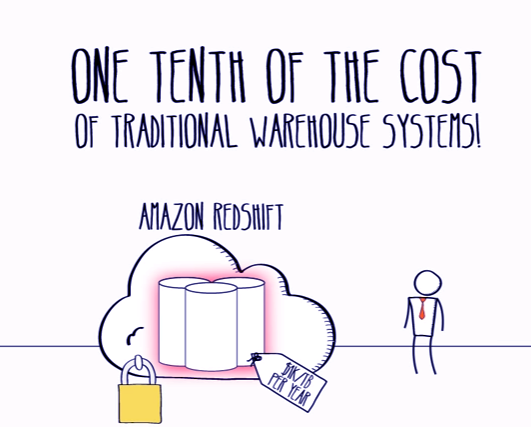Amazon Redshift Tutorial – 6 Important Benefits of Redshift
Free AWS Course for AWS Certified Cloud Practitioner (CLF-C01) Start Now!!
In our last tutorial, we talked about Amazon DynamoDB. Here, we will discuss What is Amazon Redshift. In this AWS Redshift, we are going to explore the benefits of Redshift in Amazon Web Services. Along with this, we will study how does Amazon Redshift work.
So, let’s start the AWS Redshift Tutorial.
What is Amazon Redshift?
Amazon Redshift is a data warehousing product which is a part of cloud computing platform. Redshift is fast scalable which provides the service to the user by cutting the cost and making it less complex. AWS Redshift analyzes all the data across the data warehouse and data lake.
With the help of machine learning, massively parallel query execution, and columnar storage on high-performance disk Redshift is far better in providing speed and is better at the performance levels.
The pricing of Amazon Redshift is quite low as the user can start for just $0.25 per hour and scale to $250 per terabyte per year, which is less than one-tenth the cost of other solutions.
AWS Redshift is easy to operate and scale and the user does not need to learn any new language. After just uploading the cluster and using the favourite tools one can start working on Redshift.
The only thing a user has to do is log in to Amazon Redshift and downloads AWS management console and within a few clicks, the user will be successful in operating AWS Redshift.
As the business of the user grows the Amazon Redshift grows automatically as the user can scale without any downtime. Moreover, there is no tuning needed to increase the performance as all these things are done by AWS Redshift.
Redshift uses massive parallel architecture to distribute data and queries to multiple nodes to consistently deliver high-performance data. It also continuously monitors the cluster so that the user can back up the data so that the user can restore it just within the few clicks.
Benefits of AWS Redshift
Following are the Amazon Redshift Benefits, let’s discuss them one by one:
a. Great Performance
Amazon Redshift delivers 10x higher performance than different data warehouses. It uses machine learning, a massively parallel design, compute-optimized hardware, and result set caching to deliver high outturn and sub-second response times.
With AWS Redshift, you pay less time waiting and longer gaining insights from your data.
b. Easy Management and Use
Amazon Redshift is easy to use, enabling you to deploy a replacement data warehouse in minutes. AWS Redshift automates most of the common body tasks to manage, monitor, and scale your data warehouse. This helps you separate from the complexities of managing on-premises data warehouses.
c. Economical
Amazon Redshift is that the most value effective cloud data warehouse and less than 1 /10th the price of traditional information warehouses on-premises.
There aren’t any direct prices with AWS Redshift, and you simply get what you utilize. The user begins little for simply $0.25 per hour with no commitment, and scale out for simply $250 per TB p.a.
d. Scalability
Amazon Redshift permits you to scale from querying gigabytes to exabytes across your Redshift data warehouse and Amazon S3 Data Lake.
Quickly analyze any size of data in S3 with no loading or ETL needed, and simply size your Redshift cluster with simply a couple of clicks on the console or a straightforward API decision. With AWS Redshift, you’ll rescale or down as your wants amendment.
e. Queries the Information Lake
AWS Redshift extends your data warehouse to your data lake to assist you to gain distinctive insights that you just couldn’t get by querying freelance information silos.
The user will directly question open information formats hold on in Amazon S3 with Redshift Spectrum, a feature of AWS Redshift, while not the necessity for excess data movement. This permits you to research information across your data warehouse and data lake, together, with one service.
f. Security
AWS Redshift runs mission important workloads for big money services, healthcare, retail, and government organizations. The info will be encrypted using AWS KMS or HSM.
The user will isolate your clusters using Amazon Virtual personal Cloud (VPC). AWS Redshift is compliant with SOC1, SOC2, SOC3, PCI DSS Level one needs, and FedRAMP, and HIPAA eligible with BAA accessible from AWS.
So, this was all about AWS Redshift Tutorial, Hope you like our explanation.
Conclusion
Hence, in this Amazon web services Redshift tutorial, we studied the benefits of AWS Redshift. In addition, we get to know about Amazon Redshift also provides Encryption as it has a built-in encryption, the user has to switch it on and all the data will be automatically encrypted.
In addition, SSL and Amazon VPC are also built in. The user can also pay by the hours with no upfront commitments. Amazon Redshift is preferred because of the quality it provides within the cost limit and with no upfront cost. Is this helpful to you, share with us in the comment box?
Did we exceed your expectations?
If Yes, share your valuable feedback on Google








